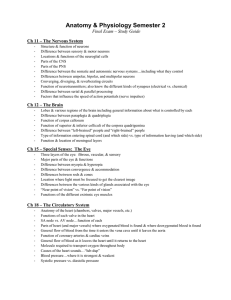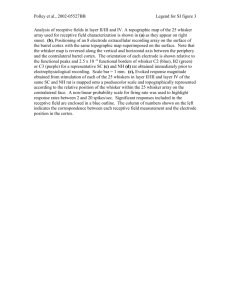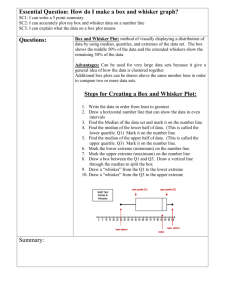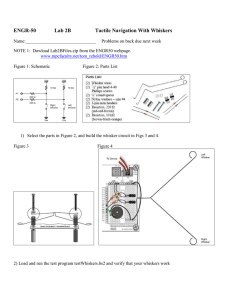1. Intro:
advertisement
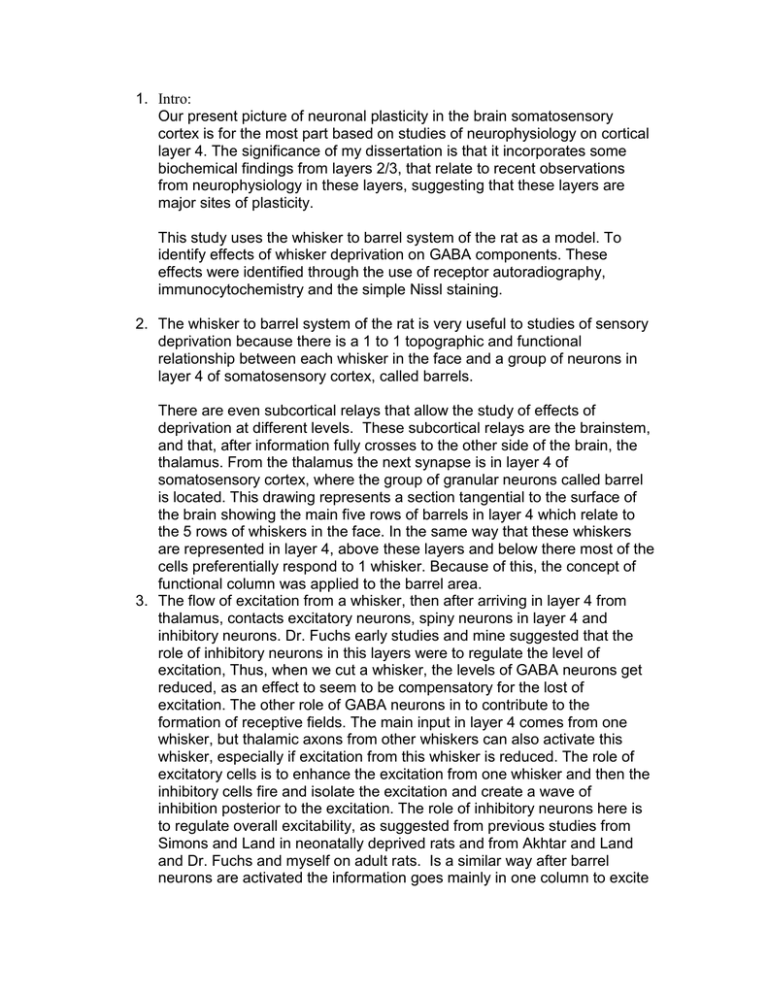
1. Intro: Our present picture of neuronal plasticity in the brain somatosensory cortex is for the most part based on studies of neurophysiology on cortical layer 4. The significance of my dissertation is that it incorporates some biochemical findings from layers 2/3, that relate to recent observations from neurophysiology in these layers, suggesting that these layers are major sites of plasticity. This study uses the whisker to barrel system of the rat as a model. To identify effects of whisker deprivation on GABA components. These effects were identified through the use of receptor autoradiography, immunocytochemistry and the simple Nissl staining. 2. The whisker to barrel system of the rat is very useful to studies of sensory deprivation because there is a 1 to 1 topographic and functional relationship between each whisker in the face and a group of neurons in layer 4 of somatosensory cortex, called barrels. There are even subcortical relays that allow the study of effects of deprivation at different levels. These subcortical relays are the brainstem, and that, after information fully crosses to the other side of the brain, the thalamus. From the thalamus the next synapse is in layer 4 of somatosensory cortex, where the group of granular neurons called barrel is located. This drawing represents a section tangential to the surface of the brain showing the main five rows of barrels in layer 4 which relate to the 5 rows of whiskers in the face. In the same way that these whiskers are represented in layer 4, above these layers and below there most of the cells preferentially respond to 1 whisker. Because of this, the concept of functional column was applied to the barrel area. 3. The flow of excitation from a whisker, then after arriving in layer 4 from thalamus, contacts excitatory neurons, spiny neurons in layer 4 and inhibitory neurons. Dr. Fuchs early studies and mine suggested that the role of inhibitory neurons in this layers were to regulate the level of excitation, Thus, when we cut a whisker, the levels of GABA neurons get reduced, as an effect to seem to be compensatory for the lost of excitation. The other role of GABA neurons in to contribute to the formation of receptive fields. The main input in layer 4 comes from one whisker, but thalamic axons from other whiskers can also activate this whisker, especially if excitation from this whisker is reduced. The role of excitatory cells is to enhance the excitation from one whisker and then the inhibitory cells fire and isolate the excitation and create a wave of inhibition posterior to the excitation. The role of inhibitory neurons here is to regulate overall excitability, as suggested from previous studies from Simons and Land in neonatally deprived rats and from Akhtar and Land and Dr. Fuchs and myself on adult rats. Is a similar way after barrel neurons are activated the information goes mainly in one column to excite 4. 5. 6. 7. 8. 9. excitatory and inhibitory cells in layers 2 and 3. By the way, since layers 2 and 3 are difficult to distinguish, usually they are grouped together as 2/3. This mainly columnar relay is largely due to the axonal organization. Most of the axons from excitatory neurons relate to the main column, as is illustrated here in this camera lucida drawing. You see in red the dendritic arbor confined to layer 4 of this excitatory cell and then most of the axons directed toward the main column. However, some of the axons here relay to layers 2/3 of the adjacent barrel. This fact together with the fact that in layers 2/3 is characterized by cortico-cortical horizontal connections that the cortex with the ability to integrate inputs from different sensory modalities from different cortical areas, makes this area functionally very dynamic. The inhibitory neurons here are responsible for refining receptive fields properties, such as surround inhibition, thresholds of excitation etc. From layers 2/3, information is relayed to far cortical areas, even the other hemisphere through callosal projections, and also to layer 5, which excites 6. In this study we only focus in layers 2/3 and layer 4. A real section from our lab showing the Monkey: Effects of sensory deprivation on GABA were widely studied pioneer studies were performed in monkeys. Monocular deprivation results in decrease on the GAD, GABA and GABA receptors Physiological studies show that trimming whiskers results in disinhibition of. In later studies show layer 2/3-dendrite arbor. so the possibilities are to study either GABA receptors in these areas or any of their subunits. The other possibility was gaba b. the mechanism of inhibition is slower with this metabotropic Conclusions a. Muscimol binding decreases in deprived related to non-deprived layers 2/3 and in 4 after adult whisker trimming in rats. b. GABAA 1 receptor subunit also decreased in layers 2/3 and in 4. c. These decreases in inhibition could account for physiological and anatomical changes shown in these layers after deprivation. d. Nissl staining decreased in deprived relative to non-deprived columns after whisker deprivation in both layer 2/3 and in 4.


